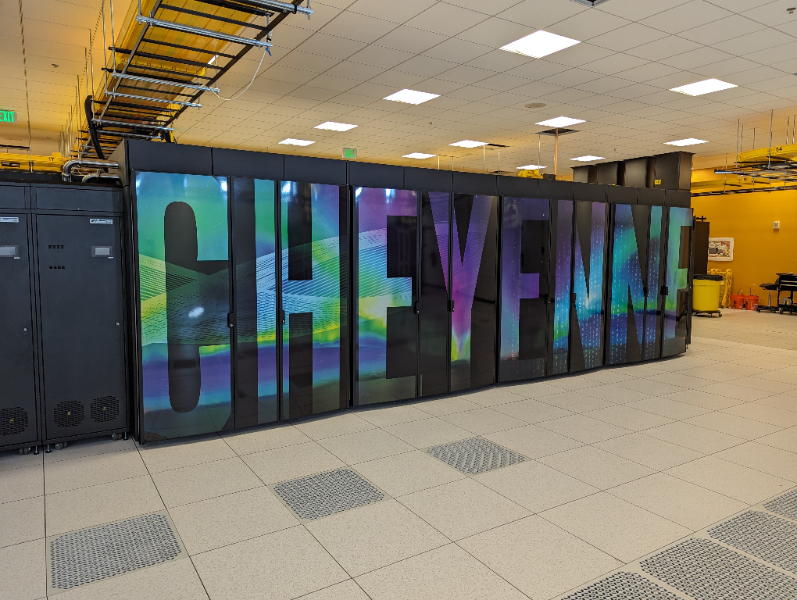Multi-million dollar Cheyenne supercomputer auction ends with $480,085 bid — buyer walked away with 8,064 Intel Xeon Broadwell CPUs, 313TB DDR4-2400 ECC RAM, and some water leaks
The glory days are over for Cheyenne.

One lucky buyer had their day yesterday as the U.S. government's online auction for its Cheyenne supercomputer ended at $480,085. The auction, first covered by Tom's Hardware on Wednesday, has closed after 27 bidders contended for a piece of supercomputing history.
The Cheyenne supercomputer's six-figure sale price comes with 8,064 Intel Xeon E5-2697 v4 processors with 18 cores / 36 threads at 2.3 GHz, which hover around $50 (£40) a piece on eBay. Paired with this armada of processors is 313 TB of RAM split between 4,890 64GB ECC-compliant modules, which command around $65 (£50) per stick online. For a deeper dive into Cheyenne's components and prime performance, check out our initial sale coverage. Unfortunately for buyers, none of the Cheyenne supercomputer's 32 petabytes of high-speed storage are being sold with the lot. Still, a savvy eBay seller could flip the processors and RAM across the machines for around $700,000 (£550,000), making a hefty profit.
This estimate assumes all of the CPUs and RAM sticks work, which is invalid. The auction site disclaims that "approximately 1% of nodes experienced failure [over the last six months], primarily attributed to DIMMs with ECC errors, which will remain unrepaired." This high failure rate is the reason for the sale, with upkeep made challenging by the fact that Cheyenne "is currently experiencing maintenance limitations due to faulty quick disconnects causing water spray." These two compounding issues have cost the Cheyenne team undue downtime and repair costs, leading them to look for a replacement, the government said.
The Cheyenne supercomputer array had a rigorous workflow over seven years of operation to earn its wear and tear. The array's services were used by scientists across the state of Wyoming and the rest of the country when needed. The 5.34-petaflop system was mainly used for weather and climate studies, helping the National Science Foundation better study climate change and other Earth-related sciences.
It isn't easy to provide an analysis of how much the government stands to lose with the sale of Cheyenne. We could not find data for the price of Cheyenne at construction, but its predecessor, Yellowstone, was quoted at $25-35 million before its construction. Some of this cost may be attributed to buildings and infrastructure surrounding the supercomputer. Still, with Cheyenne's replacement, the Derecho, costing $35-40 million from HP, Cheyenne likely initially cost around this 8-figure range as well. At a conservative estimate of $25 million for the array to be constructed, the auction sale is only 2% of the sticker price of Cheyenne. Good luck finding a 98% off sale at the following government surplus sale.
The buyer will have the joy of moving Cheyenne's 30 server racks (28 processing racks, two air-cooled management racks) out of the facility themselves; the government is not providing transport or including any Ethernet or optical cabling needed to get the machine up and running. What use a buyer might have for a malfunctioning and outdated supercomputer array is known only to them, but if you see a flood of Xeon chips hitting the market, you'll have a pretty good idea why.
Get Tom's Hardware's best news and in-depth reviews, straight to your inbox.

Sunny Grimm is a contributing writer for Tom's Hardware. He has been building and breaking computers since 2017, serving as the resident youngster at Tom's. From APUs to RGB, Sunny has a handle on all the latest tech news.
-
Alvar "Miles" Udell ReplyWhat use a buyer might have for a malfunctioning and outdated supercomputer array is known only to them, but if you see a flood of Xeon chips hitting the market, you'll have a pretty good idea why.
Well, there are probably several hundred universities, many with government or military contracts, with computers far slower than Cheyenne who could be interested in it, not to mention any number of millionaries and billionaires who would love to donate it to a university or organization, or in parts to several, for tax purposes, with the refurbishment costs likely being far lower than buying a new system. -
suryasans Reply
Since it's an outdated hardware, it may be sent to Russia via third countries. Some Russian Companies need many hardware spare parts to fix their data centers.Alvar Miles Udell said:Well, there are probably several hundred universities, many with government or military contracts, with computers far slower than Cheyenne who could be interested in it, not to mention any number of millionaries and billionaires who would love to donate it to a university or organization, or in parts to several, for tax purposes, with the refurbishment costs likely being far lower than buying a new system. -
TomOviedo They could buy one of these and have 1,000+ times more compute power. Payback time on the loss on this B-52, relatively speaking, would be pretty darn quick.Reply
https://nvidianews.nvidia.com/news/nvidia-blackwell-platform-arrives-to-power-a-new-era-of-computing
The government could also just lease space on AWS. No worries about cost of upgrades, maintenance, or leaky pipes.
It’s noteworthy that NVIDIA and AMD to a lesser extent are crushing Intel. We’re at the start of a massive data center refresh cycle to power Gen AI and on-site compute moving to the cloud. That’s NVIDIA. We’ll start seeing a lot more of these and at prices heading down. -
Robbertson As I understand it, it may cost as much to move as it did to buy it, and the monthly costs in electricity are something like $90K. Lots of big heavy cabinets, special room requirements, and you're getting a bunch of ~6th gen intel cpus.Reply -
robertque a white elephant - lucky to break even I've being doing the same thing on a much less scale for years.. always lost money.Reply